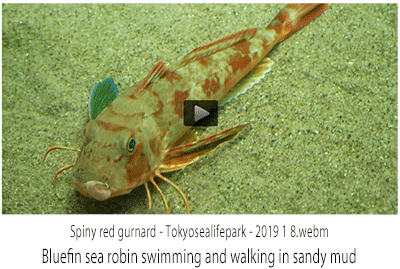| Please access the following URL if you want to secure using SSL. All pages in the site will be secure pages. |
https://secure02.blue.shared-server.net/www.fish-food.co.jp/message english 2.2021.html |
Welcome to FISH FOOD TIMES
Feb. 2021 issue No.206

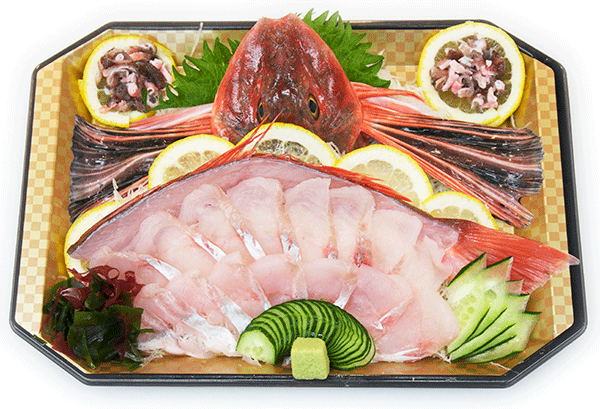
Bluefin sea robin figure sashimi
Uokagami
Although it is cold and snowy this winter, one of the fish that becomes delicious in such a cold season is the bluefin sea robin. Let's touch on the bluefin sea robin at the beginning of the book "Uokagami" written by Shusaku Takei in the 2nd year of Tenpo (1831) in the Edo period.


The passage says "The fish meat of the bluefin sea robin is white like snow, the taste is sweet and delicious, and the bluefin sea robin in the cold winter season is comparable to the taste of jyosen grade in sake."
In this way, I would like to take up the bluefin sea robin, which has long been considered to be the most delicious season in Japan, in this month's issue.
Its appearance is characteristic
The bluefin sea robin belongs to the Scorpaeniformes Order, Platycephaloidei Suborder, Triglidae family, and Chelidonichthys genus, and inhabits deep sandy mud areas that reach 600 m in depth from shallow sea sandy areas nationwide.
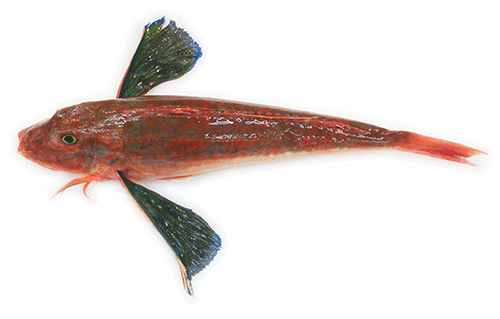

The bluefin sea robin has a characteristic shape as shown in the image, and there are countless spots on the surface of the fish, which are described as "Ruri color circle dots" in Uokagami. Furthermore, the long-shaped pectoral fin is described by Uokagami as "light red on the front and dark green on the back".
By the way, the sea robin, which is a fish very similar to the bluefin sea robin, is shown in the image below.
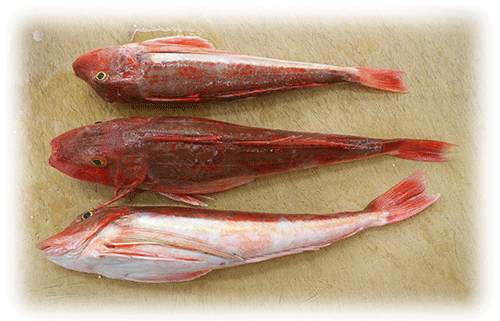
The sea robin is very similar to the bluefin sea robin, but without the "Ruri color circle dots" characteristic of the bluefin sea robin on the surface of the fish. The sea robin has a smaller pectoral fin than the bluefin sea robin and is red, and there is no dark green part in the bluefin sea robin that is described as "light red on the front and dark green on the back".
In Uokagami's explanation of bluefin sea robin, there is an expression that "there is a spine under the fin", but this is one of the major features of bluefin sea robin that cannot be handled very lightly.
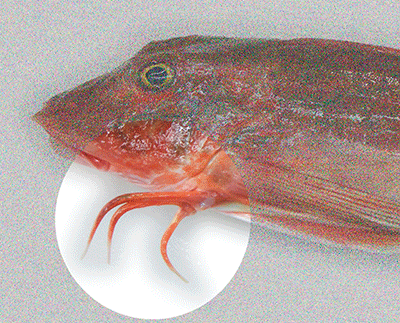
It's the circled part in the image above, but this role can be best understood by watching the free software video below, which is announced on the WIKIMEDIA COMMONS web screen.
This seems to be a video taken in the aquarium of Kasai Rinkai Aquarium. The bluefin sea robin shows the thorns of three fins with sensory organs at the bottom of the pectoral fin moving like the legs of her crab, walking on the sand. In other words, the blue fin sea robin has a total of 6 legs and can walk freely on the sand.
In the olden days, the head of the blue fin sea robin resembled a samurai armor, so it was also used as an auspicious fish in the samurai class for celebrations. In addition, as one of the roles of the prominent fish, it has been used in the same position as red sea bream in the "beginning of eating (beginning of chopsticks)" which is performed around 3 months after the baby is born. Also, sea robin is used in almost the same way as blue fin sea robin, and in Nagasaki City, sea robin is written as "gold head" and treated as a lucky charm to call fortune. In addition, Setsubun has a rare custom of eating sea robin by boiling or grilling it with salt, also known as "guts".
In this way, bluefin sea robin was also known as "Kimi no Uo" as a high-class fish eaten by the upper class until the Edo period, and was known as one of the representative players of auspicious fish and prominent fish even in the general public class.
Bluefin sea robin figure sashimi
As you can see, the blue fin sea robin is a very prominent fish, so the best commercialized form for this fish would be firure sashimi. The work process will be introduced in two parts below.
| 1 Bluefin sea robin three pieces disassembling work process | ||
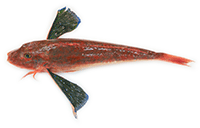 |
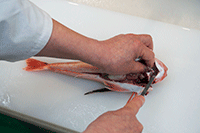 |
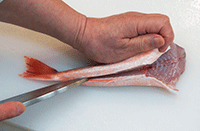 |
| Bluefin sea robin | 4.Cut off the two parts at the base of the gills and remove the internal organs together. | 8.Insert a knife from the side of the fin on the lower body side and cut over the central bone to the backbone. |
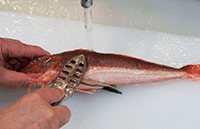 |
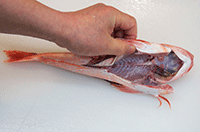 |
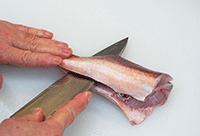 |
| 1.Scrape off small scales. | 5.Rinse so that no chiai meat of fish or internal organs remain, and wipe off the water. | 9.nsert a knife from the head and cut it off to the caudal fin by the daimyou disassembling method. |
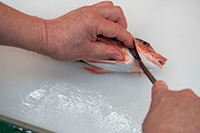 |
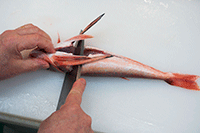 |
 |
| 2.Cut the gills film and cut off the base of the jaw. | 6.Make a knife cut under the pelvic fin with the back side down. | 10.Cut the upper body from the head and continue to the caudal fin. |
 |
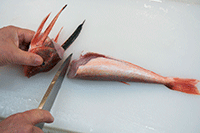 |
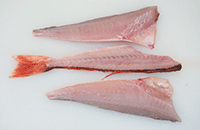 |
| 3.Divide the abdomen in two from the base of the collar of fish. | 7.Leave the left pectoral fin, cut off the head. | 11.The state of three pieces disassembling. |
| 2 work process of bluefin sea robin figure sashimi | ||
|---|---|---|
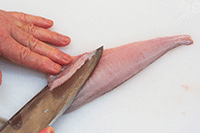 |
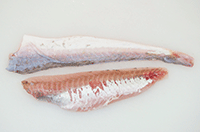 |
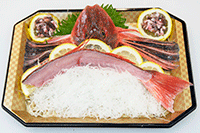 |
| 1.Cut the cutting edge under the belly bone and cut toward the end. | 6.The upper body with the skin removed. Does Uokagami's "meat snow white" mean this state? | 11.Place lemon slices on the upper right and upper left and serve with chopped skin. |
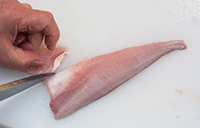 |
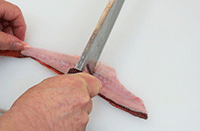 |
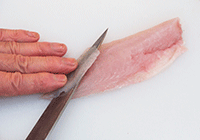 |
| 2.Shape the edges and cut off the belly bone. | 7.To make a figure sashimi, make a cut in a part of the middle bone using the blade edge for the purpose of bending the central bone. | 12.To cut the upper body with sogigir, pull the yanagiba knife and cut it. |
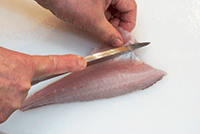 |
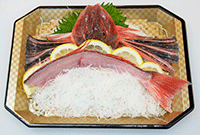 |
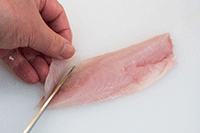 |
3.The lower part of the body also cuts under the belly bone to remove the belly bone. |
8.A state where a stand is made for figure sashimi. |
13.Stop the cutting edge with only one piece of skin left, raise the ridge of the knife, then cut off the skin and stand kirikado at an acute angle. |
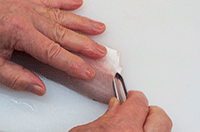 |
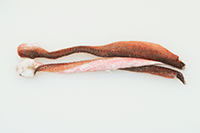 |
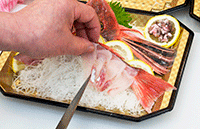 |
| 4.Remove all the small bones of both the upper and lower body using a bone removal tool. | 9.Boil the skin with boiling water and then cool to remove any water. | 14.Arrange in order from the right end to the left. |
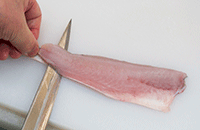 |
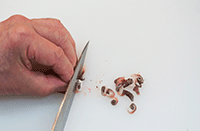 |
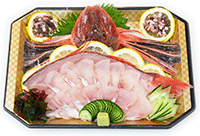 |
| 5.Remove the skin on the upper and lower body. | 10.Remove some water from the skin and chop it into small pieces. | 15.The figure sashimi of blue fin sea robin using only the upper body is completed. |
In order to maximize the value of the blue fin sea robin, which is a prominent fish, it seems best to use such a figure sashimi. However, since only the upper half of the body is used as sashimi material for this, this cost can be calculated by half of one fish.
Even with the same half-body sashimi, usutsukuri sashimi in the lower right does not seem to have volume. Whether bluefin sea robin is figure sashimi or not, there is a difference in value that comes from this volume and appearance. Therefore, I think it would be better to change the selling price of these two products and sell them in a differentiated manner.
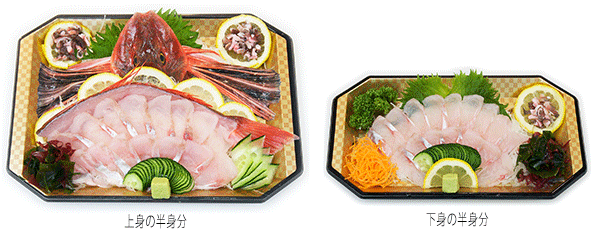
The bluefin sea robin has a long history of being used as an auspicious fish in Japan for celebrations. Therefore, in particular, figure sashimi should be proposed to customers as one of the roles of prominent fish, for example, as a product at the beginning of eating (the beginning of chopsticks), which is performed around 3 months after the baby is born.
In fact, last December, I bought about 2 kg of natural red sea bream to celebrate my grandson's beginning of eating (the beginning of chopsticks), and made a figure sashimi of sea bream to entertain my son and daughter-in-law.
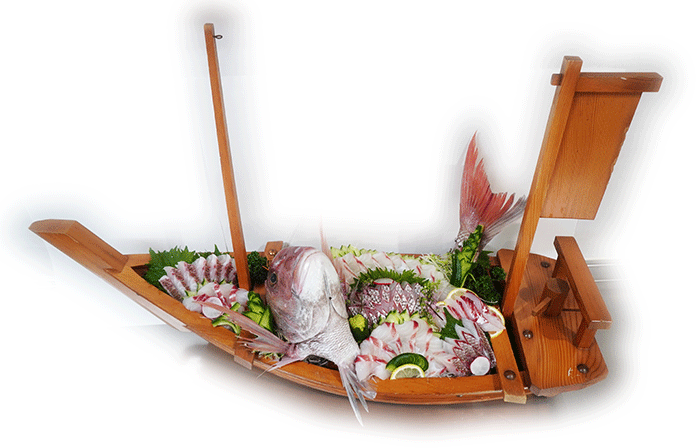
Now that we are in the Corona era, there must be a need to make something as luxurious as possible at home rather than going out and having a celebration at the store. However, there should be few ordinary people who can make something like this by themselves like the author. For example, the bluefin sea robin figure sashimi in the opening image of this month's issue is that the bluefin sea robin, which has been treated at a high price because it is a high-class fish, is now available at a fairly reasonable price. Therefore, I think we can offer it to our customers at a reasonable selling price.
Take advantage of the low price of high-class fish in the past
Recently, blue fin sea robin has become an affordable price.
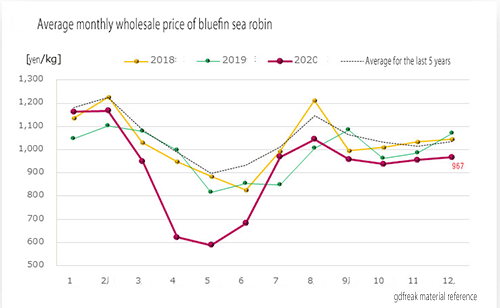
From this, the bluefin sea robin should be able to be sold as an open dried fish product or fillet as shown in the image below.

It was a long time ago that bluefin sea robin was treated as a high-class fish, and recently it has been changing at the level shown in the graph above. In other words, the bluefin sea robin now seems to be a popular fish that can no longer be called a high-class fish in terms of price.
However, the fish that have reigned as high-class fish in both name and reality are now 20 to 30% cheaper than before, and some people are mourning that even the price has dropped to half the price. Needless to say, this is due to the sharp drop in demand in the food and beverage industry due to COVID-19.
The market price of high-class fish, which crashed from the spring of 2020, seemed to have recovered slightly, but now it is in a more severe slump than last year. Fishermen are trying to keep prices by adjusting landings in anticipation of fishing, but even so, there are no signs of price recovery.
Nowadays, the industry involved in the production and distribution of marine products is relying on the retail industry such as supermarket fish counters. The fisheries division of supermarkets, which has been suffering from sluggish sales for a long time, has been in a situation where it is natural to exceed the previous year from around the spring of last year. And although there seems to be no major change in that trend, it is expected that this will also be greatly influenced by whether or not the end of COVID-19 can be seen in the future.
The fish department of the supermarket has been doing well since last year as it has been a tailwind for COVID-19 and has been pushed back. At such times, the "Ideal situation" of the fish counter will return to the starting point, and now is the time to prepare firmly so that we can meet the expectations of our customers even at the time of post-corona.
| Please access the following URL if you want to secure using SSL. All pages in the site will be secure pages. |
https://secure02.blue.shared-server.net/www.fish-food.co.jp/message english 2.2021.html |
An opinion and the communication are to iinfo@fish food times
Date of updating 1 Feb. 2021

